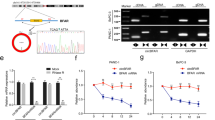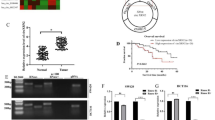Abstract
Background
Pancreatic cancer (PC) is amongst the most lethal gastrointestinal tumors, which is the seventh leading reason of cancer-related mortality worldwide. Previous studies have indicated that circular RNAs (circRNAs), which is a new type of endogenous noncoding RNA (ncRNA), can mediate tumor progression in diverse tumor types including PC. Whereas precise roles regarding circRNAs and their underlying regulatory mechanisms in PC remain unknown.
Methods
In the current study, we employed next generation sequencing (NGS) to characterize abnormally expressed circRNAs among PC tissues. Next, we assessed expression levels of one identified circRNA, circ-STK39, in PC cell lines and tissues. Then, using bioinformatics analysis, luciferase reporter, Transwell migration, EdU and CCK-8 assays, we examined the regulatory mechanisms and targets of circ-STK39. Finally, our group explored the circ-STK39 role in PC tumor growth and metastasis in vivo.
Results
Our team discovered that circ-STK39 expression increased in PC tissues and cells, suggesting that circ-STK39 may have a role in PC progression. Downregulation of circ-STK39 inhibited PC proliferation and migration. Bioinformatics and luciferase reporter outcomes demonstrated that TRAM2 and miR-140-3p were circ-STK39 downstream targets. TRAM2 overexpression reversed the miR-140-3p overexpression effects upon migration, proliferation and the epithelial-mesenchymal transition (EMT).
Conclusion
In this regard, we showed that circ-STK39 downregulation led to decreased migration, proliferation and the EMT of PC via the miR-140-3p/TRAM2 axis.






Similar content being viewed by others
Data availability
The datasets used and/or analyzed during the current study are available from the corresponding author on reasonable request.
References
Bray F, Ferlay J, Soerjomataram I, Siegel RL, Torre LA, Jemal A (2018) Global cancer statistics 2018: GLOBOCAN estimates of incidence and mortality worldwide for 36 cancers in 185 countries. CA Cancer J Clin 68:394–424. https://doi.org/10.3322/caac.21492
Klein AP, Wolpin BM, Risch HA et al (2018) Genome-wide meta-analysis identifies five new susceptibility loci for pancreatic cancer. Nat Commun 9:556. https://doi.org/10.1038/s41467-018-02942-5
Paternoster S, Falasca M (2020) The intricate relationship between diabetes, obesity and pancreatic cancer. Biochim Biophys Acta Rev Cancer 1873:188326. https://doi.org/10.1016/j.bbcan.2019.188326
Vincent A, Herman J, Schulick R, Hruban RH, Goggins M (2011) Pancreatic cancer. Lancet 378:607–620. https://doi.org/10.1016/s0140-6736(10)62307-0
Ilic M, Ilic I (2016) Epidemiology of pancreatic cancer. World J Gastroenterol 22:9694–9705. https://doi.org/10.3748/wjg.v22.i44.9694
Wong CH, Lou UK, Li Y et al (2020) CircFOXK2 promotes growth and metastasis of pancreatic ductal adenocarcinoma by complexing with RNA-Binding proteins and sponging MiR-942. Cancer Res 80:2138–2149. https://doi.org/10.1158/0008-5472.Can-19-3268
Rong Z, Shi S, Tan Z et al (2021) Circular RNA CircEYA3 induces energy production to promote pancreatic ductal adenocarcinoma progression through the miR-1294/c-Myc axis. Mol Cancer 20:106. https://doi.org/10.1186/s12943-021-01400-z
Shen P, Yang T, Chen Q et al (2021) CircNEIL3 regulatory loop promotes pancreatic ductal adenocarcinoma progression via miRNA sponging and A-to-I RNA-editing. Mol Cancer 20:51. https://doi.org/10.1186/s12943-021-01333-7
Memczak S, Jens M, Elefsinioti A et al (2013) Circular RNAs are a large class of animal RNAs with regulatory potency. Nature 495:333–338. https://doi.org/10.1038/nature11928
Qadir MI, Faheem A (2017) miRNA: a Diagnostic and Therapeutic Tool for Pancreatic Cancer. Crit Rev Eukaryot Gene Expr 27:197–204. https://doi.org/10.1615/CritRevEukaryotGeneExpr.2017019494
Chen L, Shan G (2021) CircRNA in cancer: fundamental mechanism and clinical potential. Cancer Lett 505:49–57. https://doi.org/10.1016/j.canlet.2021.02.004
Vo JN, Cieslik M, Zhang Y et al (2019) The Landscape of circular RNA in Cancer. Cell 176:869–881. https://doi.org/10.1016/j.cell.2018.12.021
Hu C, Xia R, Zhang X et al (2022) circFARP1 enables cancer-associated fibroblasts to promote gemcitabine resistance in pancreatic cancer via the LIF/STAT3 axis. Mol Cancer 21:24. https://doi.org/10.1186/s12943-022-01501-3
Li J, Sun D, Pu W, Wang J, Peng Y (2020) Circular RNAs in Cancer: Biogenesis, function, and clinical significance. Trends Cancer 6:319–336. https://doi.org/10.1016/j.trecan.2020.01.012
Alkan AH, Akgül B (2022) Endogenous miRNA sponges. Methods Mol Biol 2257:91–104. https://doi.org/10.1007/978-1-0716-1170-8_5
Wang Z, Chen K, Li D, Chen M, Li A, Wang J (2021) Mir-140-3p is involved in the occurrence and metastasis of gastric cancer by regulating the stability of FAM83B. Cancer Cell Int 21:537. https://doi.org/10.1186/s12935-021-02245-8
Chen J, Cai S, Gu T, Song F, Xue Y, Sun D (2021) MiR-140-3p impedes gastric Cancer Progression and Metastasis by regulating BCL2/BECN1-Mediated autophagy. Onco Targets Ther 14:2879–2892. https://doi.org/10.2147/ott.S299234
Wang Y, Chen J, Wang X, Wang K (2020) Mir-140-3p inhibits bladder cancer cell proliferation and invasion by targeting FOXQ1. Aging 12:20366–20379. https://doi.org/10.18632/aging.103828
Wang J, Zhu M, Zhou X et al (2020) MiR-140-3p inhibits natural killer cytotoxicity to human ovarian cancer via targeting MAPK1.J Biosci45
Liu D, Chen C, Cui M, Zhang H (2021) Mir-140-3p inhibits colorectal cancer progression and its liver metastasis by targeting BCL9 and BCL2. Cancer Med 10:3358–3372. https://doi.org/10.1002/cam4.3840
Ma J, Zhang F, Sun P (2020) Mir-140-3p impedes the proliferation of human cervical cancer cells by targeting RRM2 to induce cell-cycle arrest and early apoptosis. Bioorg Med Chem 28:115283. https://doi.org/10.1016/j.bmc.2019.115283
Hu C, Zou Y, Jing LL (2020) Mir-140-3p inhibits progression of non-small cell lung cancer by targeting Janus kinase 1.J Biosci45
Fukushima R, Kasamatsu A, Nakashima D et al (2018) Overexpression of translocation Associated membrane protein 2 leading to Cancer-Associated Matrix Metalloproteinase activation as a putative metastatic factor for human oral Cancer. J Cancer 9:3326–3333. https://doi.org/10.7150/jca.25666
Gao X, Jiang W, Ke Z et al (2022) TRAM2 promotes the malignant progression of glioma through PI3K/AKT/mTOR pathway. Biochem Biophys Res Commun 586:34–41. https://doi.org/10.1016/j.bbrc.2021.11.061
Li L, Ugalde AP, Scheele C et al (2021) A comprehensive enhancer screen identifies TRAM2 as a key and novel mediator of YAP oncogenesis. Genome Biol 22:54. https://doi.org/10.1186/s13059-021-02272-8
Acknowledgements
None.
Funding
This work was supported by grants obtained from Medical and Health Technology Plan of Zhejiang Province (2019RC179); National Natural Science Foundation of China (Grant No. 82002482); Natural Science Foundation of Zhejiang Province, Exploration Project (Grant LQ21H160034).
Author information
Authors and Affiliations
Contributions
Chao Li and Guogang Li contributed to the study conception and design. All authors collected the data and performed the data analysis. All authors contributed to the interpretation of the data and the completion of figures and tables. All authors contributed to the drafting of the article and final approval of the submitted version.
Corresponding author
Ethics declarations
Competing interests
All the authors declare that they have no conflicts of interest.
Ethics approval and consent to participate
The investigation was approved by Ethics Committee in the Second Affiliated Hospital Zhejiang University School of Medicine. All procedures performed in studies involving human participants were in accordance with the ethical standards of the institutional and/or national research committee and with the 1964 Helsinki declaration and its later amendments or comparable ethical standards. Written informed consent was obtained from individual participants or their relatives.
Additional information
Publisher’s note
Springer Nature remains neutral with regard to jurisdictional claims in published maps and institutional affiliations.
Rights and permissions
Springer Nature or its licensor (e.g. a society or other partner) holds exclusive rights to this article under a publishing agreement with the author(s) or other rightsholder(s); author self-archiving of the accepted manuscript version of this article is solely governed by the terms of such publishing agreement and applicable law.
About this article
Cite this article
Li, C., Cai, J., Liu, W. et al. Downregulation of circ-STK39 suppresses pancreatic cancer progression by sponging mir-140-3p and regulating TRAM2-mediated epithelial-mesenchymal transition. Apoptosis 28, 1024–1034 (2023). https://doi.org/10.1007/s10495-023-01813-9
Accepted:
Published:
Issue Date:
DOI: https://doi.org/10.1007/s10495-023-01813-9




